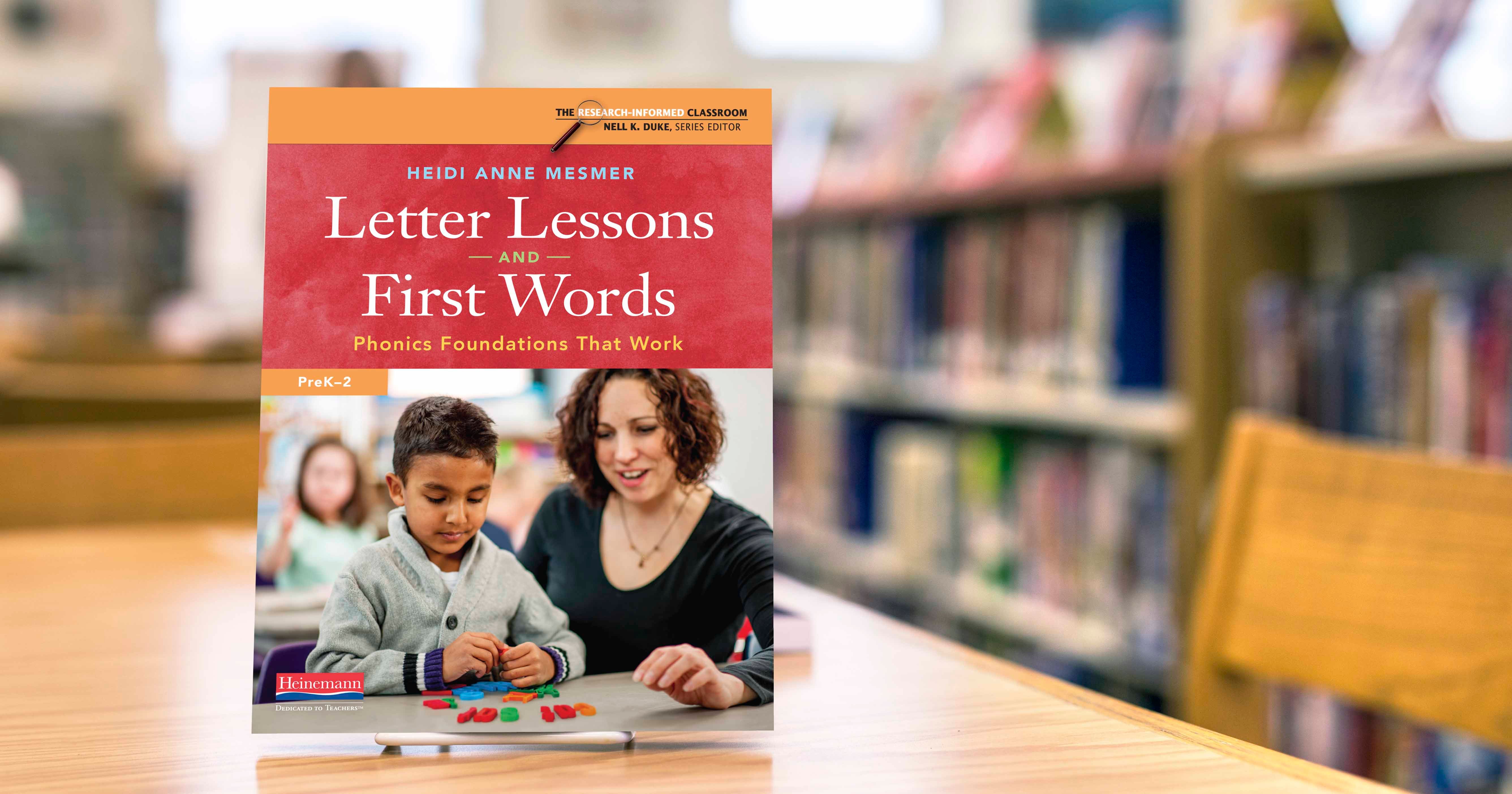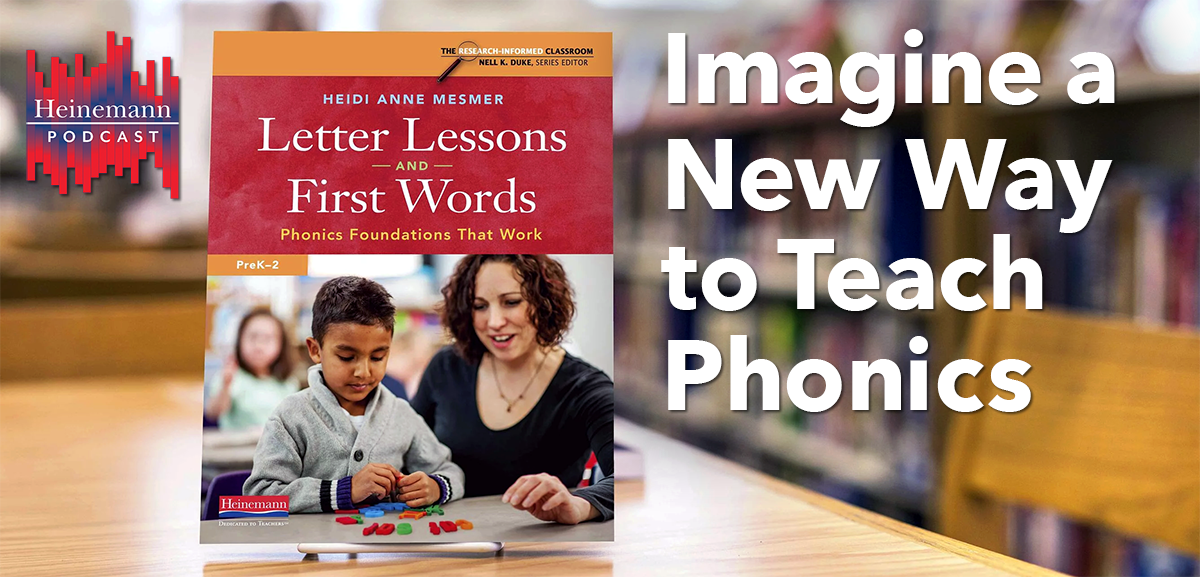
By Heidi Anne Mesmer
As the International Literacy Association stated in its recent Literacy Leadership Brief, “The question of whether to include phonics instruction has been resolved. The answer is yes.” (ILA, 2019). This is not news to most teachers but many struggle with exactly what to do during a phonics lesson.
Explained by Jenna, a first grade teacher, she says, “I knew that I was supposed be teaching phonics but I was not exactly sure what kinds of activities I was supposed to be doing, and I did not know how I was supposed to blend those activities into a lesson.” Jenna is not alone. There are so many different approaches to phonics instruction and so many strong opinions, it’s easy to get lost. But, evidence has converged on several important elements of a phonics lesson (See bibliography below.) In this blog, I share five essential, research-based parts of a phonics lesson. Of course, there are many more than five, but these top five are critical.
1. Review It
The purpose of phonics instruction is to develop automatic, error free word recognition during reading. To get this to place, students need to practice rereading words and reviewing letter-sounds at the beginning of each lesson. "I am really basic," explained David, a rather humble award-winning first-grade teacher in a large urban district. "When people ask me what my secret is, it's kind of embarrassing to tell them that I use a lot of repetition." Kindergartners should practice naming letter/sounds using alphabet arcs, alphabet charts, or magnetic letters. First graders should practice rereading words that they learned in previous lessons. Usually about five minutes, brisk reviews work because they capitalize on two concepts, overlearning and distributed practice. A recent article in Scientific American, explains that practicing a skill beyond the point of mastery, or overlearning it, solidifies it (Turner 2017). Distributed practice is shorter practice sessions that take place over longer periods of time, which contrasts with “cramming,”—longer practice sessions that take place over a shorter period.
2. Hear It: Phonological Awareness
In the 1980s and 1990s we learned that, in order to make use of phonics instruction, students must be able to hear sound differences in their language. Phonological awareness is the ability to hear, identify, and manipulate different sound units, orally. It might include orally identifying a word that rhymes with can, identifying the /s/ sound at the beginning of sing, or breaking the word bag into its parts /b/ /a/ /g/. Not to be confused with phonics, which is associating a grapheme made of letters with a phoneme, phonological awareness is a critical insight that undergirds phonics instruction.
Every phonics lesson needs to have a phonological awareness part that “primes” students for the target content and skill being used. For example, if a lesson is going to focus on learning how to read words with the at word family, students would blend and segment those sounds orally (/a/+ /t/ = at) or identify pictures of words that rhyme with at. If the lesson focuses on the /f/ sound students would practice saying the names of pictures (e.g., mat, fish, cat) and identifying those that begin with /f/ sound. Phonological awareness front-loads phonics. It prepares students to add the letter component when they decode. (Note: research suggests that pairing phonemic awareness with letter and decoding instruction is effective.)
3. Decode It: Sounding Out Words
As obvious as it seems, phonics lessons need to include ample practice “sounding out” lots of individual words independently. I often see phonics lessons where teachers model, children repeat what the teacher did, and then at the end children may practice sounding out 1-2 words by themselves. Imagine if you went to a ski lesson and the instructor spent 20 minutes of the lesson showing you how to stop, turn, and move but then only gave you two shots at “going down the hill?” That’s what it’s like in some lessons.
For example, in a lesson that focuses on –in and –it words, the lesson might begin with the teacher modeling how to sound out the word families –in and –it and then how to put a new sound on the beginning, f-it, f-in. However, the bulk of the lesson would be asking the children to attempt to decode new words with these parts (e.g. pit, pin, hit, tin). As students are decoding, the teacher provides specific, corrective feedback that challenges them to put the word together themselves (e.g., “That’s not met. Take a look at the last letter /mmmmeeee[n]/ [men].”) Games and word sorts are great ways to practice decoding. (Some teachers cringe at the thought of focusing on individual words. Of course, students must read in connected text (See next section), but the work of decoding is so demanding that students need space to focus on it.)
4. Spell It
Effective phonics lessons ask students to practice spelling words without word cards or other visual reminders. Think about it, really learning words means learning specific sequences of letters. Practice spelling words letter-by-letter gives students formidable practice recalling those sequences. Some approaches use dictation where the student or the teacher creates a sentence to be spelled. Spelling can also be done with word ladders, dry erase boards, or magnetic letters.
Spelling is also a natural, formative assessment. Watching children spell words tells us what they really understand. Often students will be able to read words but then show that their knowledge is not completely solid because they cannot yet spell the words. For instance, if a child writes stop as sop we can know that they really have not yet retained the consonant blend part at the beginning of the word st –even if they were decoding st- words. When a child can spell a word, we know that the knowledge is completely mastered.
5. Read It
At the end of a phonics lesson, students need to read a piece of connected text that has some words to which they can apply their new knowledge. This helps them to transfer what they have learned to reading—the very goal of phonics instruction. Without this "read it" step, phonics knowledge will live in a lonely space in the brain unaccessed and inert. Reading at the end of a phonics lesson can be in the form of individual little books, charts, or big books. It is very important that the books contain opportunities to practice decoding in context.
In kindergarten, when students are learning letter/sounds, and cannot sound out words, use repetitive, predictable text with a repeated sentence-stem (e.g., Look at my shoes. Look at my pants.) Also useful at this stage, are caption books with words that begin with the target sound along with pictures (e.g., The paint. The paper. The pencil. The pen.) These books do not really support decoding per se, but they do support concept of word and require children to use beginning sound information. These types of books also show students that what they have learned during lessons has a “real reading” application.
Once students are able to sound out words, I then use text with some decodability. Also called accountable text, these books contain words with taught phonics content and known high-frequency words. They can be highly decodable repeating just one pattern in many positions (e.g. "Big pig does a jig.") or somewhat decodable, positioning several patterns in one key position (e.g. "I like to win. I like to pin. I like to sip. I like to dip.") Neither savior nor devil, decodables provide key reading practice at specific developmental stages.
∴ ∴ ∴ ∴
So, if you are a new teacher, moving into a primary grade, or just want some basic guidance about phonics instruction, you can use these five parts to help you. Each research-based element packs a powerful punch.
 Heidi Anne E. Mesmer, PhD, is a Professor in Literacy in the School of Education at Virginia Tech. A former classroom teacher, she works extensively with teachers, schools, and young readers, directing numerous school-based initiatives to improve reading instruction. Heidi Anne studies beginning reading instruction and text difficulty and her work has been published in The Reading Teacher, Reading Research Quarterly, The Educational Researcher, Elementary School Journal, and Early Childhood Research Quarterly. She is the author of Tools for Matching Readers to Texts, Reading Interventions in Primary Grades, and Teaching Skills for Complex Texts.
Heidi Anne E. Mesmer, PhD, is a Professor in Literacy in the School of Education at Virginia Tech. A former classroom teacher, she works extensively with teachers, schools, and young readers, directing numerous school-based initiatives to improve reading instruction. Heidi Anne studies beginning reading instruction and text difficulty and her work has been published in The Reading Teacher, Reading Research Quarterly, The Educational Researcher, Elementary School Journal, and Early Childhood Research Quarterly. She is the author of Tools for Matching Readers to Texts, Reading Interventions in Primary Grades, and Teaching Skills for Complex Texts.
Follow Heidi Anne on Twitter @haemesmer
Bibliography
Adams, M. J. (1990). Beginning to Read: Thinking and Learning about Print. Urbana- Champaign, IL.: University of Illinois.
Anthony, J. L., & Francis, D. J. (2005). Development of phonological awareness. Current Directions in Psychological Science, 14(5), 255-259.
Armbruster, B. B., Lehr, F., Osborn, J., & Adler, C. R. (2003). Putting Reading First: The Research Building Blocks for Teaching Children to Read: Kindergarten Through Grade 3. National Institute for Literacy, National Institute of Child Health and Human Development, US Department of Education.
Carroll, J. M., Snowling, M. J., Stevenson, J., & Hulme, C. (2003). The development of phonological awareness in preschool children. Developmental Psychology, 39(5), 913- 923.
Cheatham, J. P., & Allor, J. H. (2012). The influence of decodability in early reading text on reading achievement: A review of the evidence. Reading and Writing, 25(9), 2223-2246.
Ehri, L. C. (2005). Learning to read words: Theory, findings, and issues. Scientific Studies of Reading, 9, 167-188. doi:10.1207/s1532799xssr0902_4
Elkonin, D. B. (1963). The psychology of mastering the elements of reading. Educational psychology in the USSR, 165-179.
Hulme, C., Muter, V., & Snowling, M. (1998). Segmentation does predict early progress in learning to read better than rhyme: A reply to Bryant. Journal of Experimental Child Psychology, 71(1), 39-44.
Hulme, C., Hatcher, P. J., Nation, K., Brown, A., Adams, J., & Stuart, G. (2002). Phoneme awareness is a better predictor of early reading skill than onset-rime awareness. Journal of experimental child psychology, 82(1), 2-28.
Hulme, C., Hatcher, P. J., Nation, K., Brown, A., Adams, J., & Stuart, G. (2002). Phoneme awareness is a better predictor of early reading skill than onset-rime awareness. Journal of experimental child psychology, 82(1), 2-28.
International Literacy Association (2019). Literacy Leadership Brief: Explaining Phonics
Instruction, An educators guide. Newark, DE: Author. Available at https://literacyworldwide.org/docs/default-source/where-we-stand/ila-explaining-phonics-instruction-an-educators-guide.pdf
Invernizzi, M., & Hayes, L. (2004), Developmental-spelling research: A systematic imperative. Reading Research Quarterly, 39: 216–228.
Jones, C. D., & Reutzel, D. R. (2012). Enhanced alphabet knowledge instruction: Exploring a change of frequency, focus, and distributed cycles of review. Reading Psychology: An International Journal, 33(5), in press.
Lonigan, C. J., & Shanahan, T. (2009). Developing Early Literacy: Report of the National Early Literacy Panel. Executive Summary. A Scientific Synthesis of Early Literacy Development and Implications for Intervention. National Institute for Literacy.
McCandliss, B., Beck, I. L., Sandak, R., & Perfetti, C. (2003). Focusing attention on decoding for children with poor reading skills: Design and preliminary tests of the word building intervention. Scientific studies of reading, 7(1), 75-104.
Moats, L. C. (1998). Teaching decoding. American Educator, 22(1), 42-49.
Muter, V., Hulme, C., Snowling, M., & Taylor, S. (1998). Segmentation, not rhyming, predicts early progress in learning to read. Journal of experimental child psychology, 71(1), 3-27.
Group Size and Activity Context. Early Education and Development,20(1), 53-79.
Piasta, S. B., & Wagner, R. K. (2010). Developing early literacy skills: A meta‐analysis of alphabet learning and instruction. Reading research quarterly, 45(1), 8-38.
Rasinski, T. V. (2008). Daily Word Ladders: Grades 1-2. New York: Scholastic.
Reutzel, D. R., Cooter, R. B., & Reutzel, D. R. (2013). The essentials of teaching children to read: The teacher makes the difference (3rd ed.). Boston: Pearson.
Share, D. L. (1995). Phonological recoding and self-teaching: Sine qua non of reading acquisition. Cognition, 55, 151-218.
Share, D. L. (2004). Orthographic Learning at a Glance: On the time course and developmental onset of self-teaching. Journal of Experimental Child Psychology ,87(4), 267-298.
Share, D. L. (2008). On the Anglocentricities of current reading research and practice: The perils of overreliance on an "outlier" orthography. Psychological Bulletin ,134(4), 584- 615.
Share, D. L. (2004). Knowing letter names and learning letter sounds: A causal connection. Journal of experimental child psychology, 88(3), 213-233.
Snow, C. E., Burns, M. S., & Griffin, P. (1998). Preventing reading difficulties in young children committee on the prevention of reading difficulties in young children. Washington, DC: National Research Council.
Stahl, S. A., Duffy-Hester, A. M. and Stahl, K. A. D. (1998). Everything you wanted to know about phonics (but were afraid to ask). Reading Research Quarterly, 33: 338–355. doi:10.1598/RRQ.33.3.5
Treiman, R. (1993). Beginning to spell: A study of first-grade children. New York: Oxford University Press.
Treiman, R., Tincoff, R., Rodriguez, K., Mouzaki, A., & Francis, D. J. (1998). The foundations of literacy: Learning the sounds of letters. Child Development, 69, 1524- 1540.
Turner, V. S. (2017). The power of overlearning. Scientific American,317 (2).
Ziegler, J. C., & Goswami, U. (2005). Reading acquisition, developmental dyslexia, and skilled reading across languages: a psycholinguistic grain size theory. Psychological bulletin, 131(1), 3.




